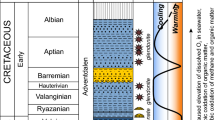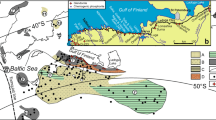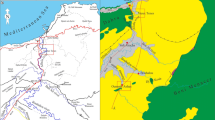Abstract
The relation of two well-known ancient carbonate deposits to hydrocarbon seepage was confirmed by this study. Archaea are found to be associated with the formation of Oxfordian seep carbonates from Beauvoisin and with a Miocene limestone from Marmorito ("tube-worm limestone"). Carbonates formed due to a mediation by archaea exhibit extremely positive or extremely negative δ13Ccarbonate values, respectively. Highly positive values (+15‰) reflect the use of 13C-enriched CO2 produced by methanogenesis. Low δ13C values of the Marmorito carbonates (–30‰) indicate the oxidation of seepage-derived hydrocarbons. Likewise, the δ13C content of specific tail-to-tail linked isoprenoids, biomarkers for archaea, was found to be strikingly depleted in these samples (as low as –115‰). The isotopic signatures corroborate that archaea were involved in the cycling of seepage-derived organic carbon at the ancient localities. Another Miocene limestone ("Marmorito limestone") shows a strong imprint of methanotrophic bacteria as indicated by δ13C values of carbonate as low as –40‰ and biomarker evidence. Epifluorescence microscopy and field-emission scanning electron microscopy revealed that bacterial biofilms were involved in carbonate aggregation. In addition to lucinid bivalves previously reported from both localities, we infer that sponges from Beauvoisin and tube worms from Marmorito depended on chemosynthesis as well. Low δ13C values of nodules related to sponge taphonomy (–27‰) indicate that sponges might have been linked to an enhanced hydrocarbon oxidation. Tube worm fossils from Marmorito closely resemble chemosynthetic pogonophoran tube worms from Recent cold seeps and are embedded in isotopically light carbonate (δ13C –30‰).
Similar content being viewed by others
Author information
Authors and Affiliations
Additional information
Received: 13 October 1998 / Accepted: 5 February 1999
Rights and permissions
About this article
Cite this article
Peckmann, J., Thiel, V., Michaelis, W. et al. Cold seep deposits of Beauvoisin (Oxfordian; southeastern France) and Marmorito (Miocene; northern Italy): microbially induced authigenic carbonates. Int Journ Earth Sciences 88, 60–75 (1999). https://doi.org/10.1007/s005310050246
Issue Date:
DOI: https://doi.org/10.1007/s005310050246




